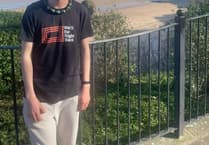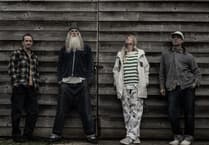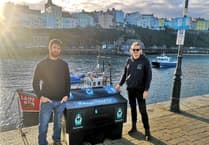It started to snow at 3 pm on Boxing Day afternoon; tiny dry flakes whipped up on a south-east wind, eddying and drifting immediately on the dry pavements and verges. The sky was sullen grey and you could hardly see Caldey Island across a threatening choppy sea veiled by snow flurries.
We were living temporarily in Harries Street in Tenby pending the completion of our new bungalow in early January. It was a cosy little house, warm and welcoming and very convenient for town.
The wind increased in strength as darkness fell and soon there were drifts of snow covering our Morris Minor convertible parked outside.
At around 8 pm I decided to take the dog for a walk around town via the South Beach Pavilion and so along the Esplanade. The biting wind made it difficult to walk and the icy snowflakes, now a howling blizzard, beat your eyes as I walked doubled up towards the shelter of the town.
By morning the town was covered in a white mantle with carved drifts at every corner. Little stirred except the milkman and one or two shops open for essential groceries. It was biting cold and the sky still a sullen grey.
Reports started to come in of huge drifts at the top of Gumfreston and the village of St. Florence was cut off. Public transport was at a stop.
So it continued every day with frequent snow flurries ,and transport was confined to the railway from Pembroke Dock to Whitland.
On New Year's Eve, 1962, there was another howling blizzard throughout the night and on New Year's Day nothing moved. Coal was getting in short supply and though Tenby was not completely snowed in compared with other outlying exposed places, you could not get in or out of the town due to icy roads which made travelling up hills almost impossible.
Thank goodness the shops were still well stocked after the Christmas rush, so food was not short. Coal came in on railway trucks and was distributed from the station yard, and visitors in the large hotels had to extend their stay.
The weather showed no sign of changing in that first week of the new year. The temperatures plummeted at night, so during the day the snow remained hard packed. Once you approached Gumfreston Hill you had to walk. On each side of you across the open fields were high walls of drifted snow.
In those days there was the notorious hair-pin bend at Wedlock, completely blocked with drifts six to nine feet high and no sign of the roadway to Ivy Tower and Sageston.
By January 6, Tenby had been cleared of snow in the streets. The sun shone from a cold blue sky with still a bitter wind from the east. Single traffic was possible to Kilgetty, but all minor roads remained blocked.
The new school term had started, and we travelled by train to Pembroke Dock where the town itself was clear of snow. But there were only town pupils to teach. The majority of pupils from Amroth to Angle could not get to school, for country roads were blocked. No-one could travel up St. Daniels Hill, west of Pembroke, and the Angle lifeboat was the only means of access to the Castlemartin peninsula.
We were in the grip of an Arctic winter, very similar to that of 1947, and it showed no sign of changing. Every day was bright and sunny, but in the shade temperatures remained below zero.
Tenby became a little 'oasis' of clear streets and green grass, yet less than a mile away the surrounding countryside was completely snowbound.
It was January 15 before the Silcox buses could safely get over the top of Gumfreston, and byroads remained impassable for weeks. In fact, the road to Whitland from Llanteg and Tavernspite was closed until Good Friday!
There was no let up and the great freeze was countrywide. Fuel supplies started to run out, fresh vegetables disappeared because they could not be harvested from the frozen ground.
Late January and early February saw further heavy snowfalls in all areas except Tenby. The Arctic weather created a national emergency. In many areas, shops had to introduce rationing due to lack of supplies. You had to queue for potatoes and vegetables, loaves of bread were rationed and soon there was a shortage of tinned food.
No building work could proceed, so our new home remained half-finished. Frost put paid to any chance of an early completion.
February half-term saw no change in the weather and it was not until St. David's Day that all traces of the now dirty grey snow disappeared.
Farmers became concerned about the early potato crops, for no planting could take place. Grass was burnt brown by the searing winds and all looked weary and forlorn.
Then suddenly, as if by magic as March arrived, so did spring! Temperatures soared, the frost relaxed its iron hard grip and up came the daffodils. It was a wonderful year for primroses, and so by the first official day of spring, South Pembrokeshire was once again green and pleasant.
What a transformation as the potatoes were planted and the earth responded to the surge in temperature, our new home was ready for occupation on April Fool's Day and we moved in on a glorious spring day. Memories are short and by the beginning of May we had forgotten about the coldest winter of the century!
Looking back now, it was a period of wonderful co-operation by everyone in that almost three months of bitter weather. It showed how adversity draws people closer together. And so it always will be.
Believe it or not, but that spring and early summer brought bumper crops of early potatoes at the usual time. So much so, the market collapsed and prices were so low, by the end of June hundreds of acres were left not harvested, for there was no price for them. Sheep were turned on them and many were lifted to be used as cattle feed or as seed for next year. After 1963, only the most favourable coastal areas grew earlies in any quantity.
Mike Evans



